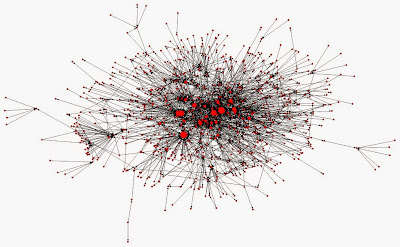This is an important question for people in the antiwar movement, since we can't count on the mainstream media to carry our message for us.
Well, as it turns out, the mainstream media has come to the conclusion that it can't count on traditional channels either!
In "USA Today Goes Viral" (New York Times, July 14, 2014), we learn that the paper with one of the largest daily circulations in the country has seen the handwriting on the wall and is requiring all its journalists to learn to drive readership via social media.
For Social Media Tuesdays, the staff must act as if there is no other way to get their articles except through sites likes Facebook and Reddit. That means USA Today’s journalists diligently place each of their famously punchy, graphic-rich stories onto various social media platforms. The purpose is to get them thinking like their readers, who increasingly get news through their Twitter feeds instead of the paper’s front page or home page.
As I read the article, I kept hearing echoes of lessons that I have been learning in the last several years as I have worked to communicate online about peace and justice issues. Herewith the top of my hit parade, with reference to stories from the USA Today newsroom . . . .(1) FIRST PRIORITY: Get the story out there
Social media is not the place for long-form journalism. If you've got one thing worth telling, get it out there . . . NOW! It doesn't have to be lengthy to "big."
(Or, as they say at USA Today: "A premium is placed on reporters’ speed and digital output. . . . 'Reporters have to write 5- and 30-minute stories.'")
Some of us find this incredibly liberating: no more writer's block! (Hey, it's binary: you either have an idea or you don't.)
(2) So: how "big" does a story have to be?
Big enough to be worth clicking to via Twitter.
(USA Today: "[R]eaders . . . increasingly get news through their Twitter feeds instead of the paper’s front page or home page.")
Steven Covey, of 7 Habits of Highly Successful People fame, used to say, "Start with the end in mind." So . . . start with the tweet in mind.
(3) What's the rush?
The flip side of being allowed to be brief is you can't procrastinate.
(USA Today: "Too many daily newspapers still focus on reporting what happened yesterday, despite many readers having learned yesterday what happened yesterday.")
Rule of thumb: Think of the information you have as having a half-life of about a day.
(4) Measure results
The coin of the realm is viewership numbers. After all, if no one's getting the message, why bother?
(The USA Today version: "All of the paper’s journalists have tools allowing them to track the online viewership of their stories." )
If you don't get jazzed looking at how much your numbers have climbed every morning with your morning coffee, this isn't the place for you.
(5) Cultivate your channels
Want to be heard on Twitter? That takes followers, and you need to build followership steadily over time.
(USA Today: "Competitions have included who can . . . add the most new Twitter followers in a given time.")
Of course, the best kind of followers are those that have lots of followers (that have lots of followers (that have lots of followers . . . . See Invite More People into Activism! (Pass It Along!)
One lesson that's not in the USA Today story: "Everything's connected." For instance . . .
TO BE CONTINUED . . . .
Related posts
 There is an eerie similarity between events in the book Paul Revere's Ride and events in our world today. I'm thinking particularly of how a network of mass resistance springs into action.
There is an eerie similarity between events in the book Paul Revere's Ride and events in our world today. I'm thinking particularly of how a network of mass resistance springs into action.(See New World Counterinsurgency: Deja Vu All Over Again)
 The biggest single eye-opener for me came this morning when I was
trading emails with Washington Post reporter Peter Slevin. I expressed
amazement at the 286 comments that people had appended to his piece on
the use of the Thomson Correctional Center to house Guantanamo detainees. (That's a lotta comments!) Peter said, "Yeah, well, that one got picked up by the Huff Post . . . ."
(See The World Turned Upside Down - Huff Post, Wash Post, and Twitter )
The biggest single eye-opener for me came this morning when I was
trading emails with Washington Post reporter Peter Slevin. I expressed
amazement at the 286 comments that people had appended to his piece on
the use of the Thomson Correctional Center to house Guantanamo detainees. (That's a lotta comments!) Peter said, "Yeah, well, that one got picked up by the Huff Post . . . ."
(See The World Turned Upside Down - Huff Post, Wash Post, and Twitter ) The reason I think Google+ will be very important for people working on
various issues -- often referred to as "communities of interest" -- is
that it is an environment that enables and encourages the sharing of
information from person to person, and also from group to group.
The reason I think Google+ will be very important for people working on
various issues -- often referred to as "communities of interest" -- is
that it is an environment that enables and encourages the sharing of
information from person to person, and also from group to group.(See Share THIS on Google+ !)
Read about the #AfghanistanTuesday campaign - in which people made time every week to remember what's happening in Afghanistan and push for change.
(See Making an Impact on #AfghanistanTuesday)
 I've
started to organize some of the practices I've discovered, starting
with the ten "guideposts" below. I'll expand on these from time to time,
and hope to spur continued conversation with all of you!
I've
started to organize some of the practices I've discovered, starting
with the ten "guideposts" below. I'll expand on these from time to time,
and hope to spur continued conversation with all of you! (See Twitter: Scarry's Ten Guideposts )
 The tremendous contribution of the "Op-Chart" is the way it reminds us that there are actual people -- many, many
people -- behind the statistics in the news we read each day about
Afghanistan, and that the events are happening in a real, physical place
that you can relate to via a map, and that the events that are
occurring on our authority are cumulative -- they add up to a large number of people. Beyond that, however, there is a problem with the "Op-Chart": it doesn't
actually do a very good job helping us detect the patterns in the
assembled information.
The tremendous contribution of the "Op-Chart" is the way it reminds us that there are actual people -- many, many
people -- behind the statistics in the news we read each day about
Afghanistan, and that the events are happening in a real, physical place
that you can relate to via a map, and that the events that are
occurring on our authority are cumulative -- they add up to a large number of people. Beyond that, however, there is a problem with the "Op-Chart": it doesn't
actually do a very good job helping us detect the patterns in the
assembled information. (See Tufte, Faces, and Afghanistan Casualties )



No comments:
Post a Comment